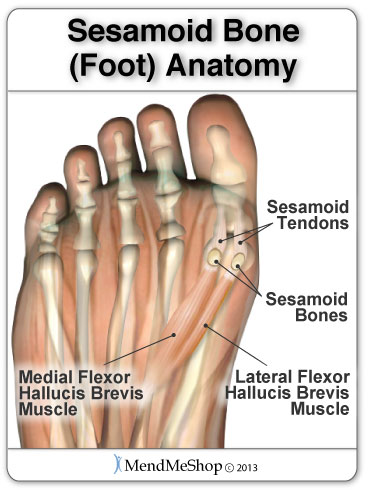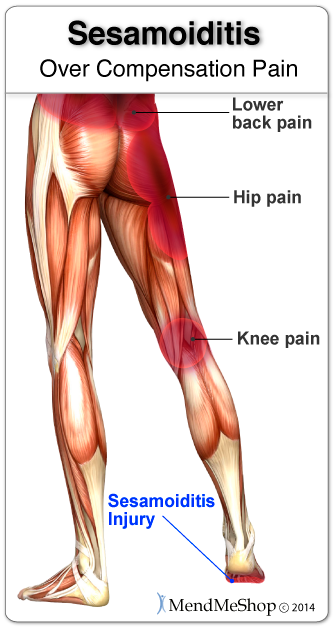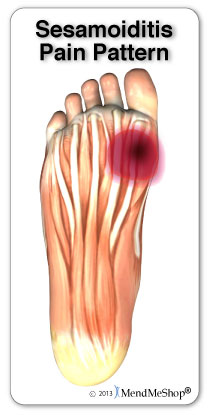Sesamoiditis is a general medical term used to describe any kind of injury that causes irritation in and around the sesamoid bones. This includes tendonitis (inflammation in the tendon tissue) surrounding the sesamoid bones and any kind of fracture or damage to the bone as well. Sesamoiditis may cause pain and inflammation in the sesamoid tendons that surround the sesamoid bones. This inflammation can spread further into more tendons and ligaments of the ball of the foot if not dealt with quickly.
Overall, this condition will make it extremely painful to walk, as fresh waves of pain can be felt every time the big toe moves or is stressed while walking or doing any other sort of activity. To reduce pressure on the big toe while walking, most people will try to walk while applying their weight only on the heel of their foot and turn the affected leg out to one side - creating a shuffling / limping type of movement.
Long-term changes in your gait (the way you walk) - such as shuffling to reduce pain on the ball of your foot - can impact other areas of your body and possibly result in something called 'over compensation pain'.

Everything in the human body is connected. A sesamoiditis injury can lead to other injuries over time if not treated properly. You might start shuffling on the heel of your injured foot and place more weight on your opposite, healthy foot. Shuffling your way around for a long period of time may lead to pain in the heel of your foot, knee, hip or lower back on your injured side because you are mis-aligning your entire leg (keeping it straight and off to the side) to compensate for the injury.


If you have sesamoiditis you may experience:


If any of those statements are true for you or you're suffering from on-going pain under your big toe or at the front of your foot then you might have an injury called "Sesamoiditis". It's an injury that's not commonly heard - people are more likely to understand that they might have plantar fasciitis, tendonitis or some other injury in their foot.
If you have it, you know that sesamoiditis is a very painful injury affecting the soft tissue and bone in the ball of your foot. It happens mostly to those who regularly puts significant, recurring pressure on the front of their foot.
Sesamoiditis is one of those injuries that can really bring down the quality of your life. Anyone - young or old - can suffer from this injury, and if you're active this condition will keep you from doing the things you love to do. It will even start interrupting any of your normal daily tasks and make living life harder than it really needs to be.
Sesamoiditis can happen when you increase the pressure on the ball of your foot in activities like running, playing basketball, football, golf, tennis, taking a step class or ballet lessons. In activities like running, more than half of our weight-bearing travels through our big toe and sesamoid bones (reference: 1).
Any changes to the structure of your foot can also lead to sesamoiditis. This would include if you already have high arches, wear high-heeled shoes regularly, wear a new pair of shoes that don't give your toes enough room, naturally run or walk on the balls of your feet or have bony feet without enough fat to cushion your sesamoid bones.


The best way to diagnose this condition is with a quick visit to the your doctor for a physical examination of your foot. The doctor will be looking for tenderness at the sesamoid bones just below your big toe.
Are you having trouble bending and straightening your toe?
Range of motion movements / tests, will be done to see how much movement has been lost in the toe. Your foot might hurt from the doctor poking and prodding at it, but by doing this the doctor will know for sure the source of your pain, the level of tenderness in and around your sesamoids and how well your toe can move with this condition.
Your doctor may also consider any previous foot injuries or joint stiffness that you may have had in the past. This will help the doctor to determine if you have a more complex injury in your foot and rule out any other foot injuries that may be present.
An x-ray of the foot will ensure proper diagnosis, sometimes they will x-ray both feet looking for similarities in bone structure when comparing both of your feet. This x-ray will show your sesamoid bones and whether there is any separation in each bone. For approximately 10 to 30% of people the sesamoid bone closer to the middle of the foot (the medial sesamoid) will be naturally divided into 2 or more pieces (reference: 1, 2, 3).
The doctor will have to find out if you naturally have a divided sesamoid bone OR if you have a fracture in this bone. If you do have any evidence of separation it's likely your doctor will have to perform more tests to find out for sure if you have a fracture in these bones.
Usually if the x-ray shows the bone is jagged there may be a fracture in the sesamoid bone, and if the separation is smooth then this means you have a naturally separated sesamoid bone.

Other tests like a bone scan, MRI (magnetic resonance imaging) or blood tests may be done if an x-ray looks normal or the doctor is unsure whether you have a fracture or natural separation in your sesamoid. These tests will also rule out any infections of the bone or tissue and help to determine if you are suffering from other injuries around your sesamoids - like arthritis or gout.
A 'sesamoid' bone is a bone that's not connected to any other bone. Sesamoids are connected to tendons or embedded in muscles. We have many sesamoids in the body - your knee cap being the largest sesamoid bone. They are also found in our hands and feet, and the sesamoid bones in the foot are where the most common sesamoiditis problems occur.
Sesamoids in the foot have three jobs, first they help the big toe move (providing a smooth surface for the tendons controlling your big toe to move) . Second, they provide you the leverage your need when you 'push off' with your foot (they act like pulleys helping to move other tissue that control your big toe). And third, they absorb the weight placed on the ball of your foot when you walk, run or jump.

Our feet are one of the most complicated joints in our bodies with 26 bones, 33 joints and more than 100 tendons, muscles and ligaments (reference: 1). Big toe pain can be from injuries to the sesamoid bones or the soft tissue in the foot, some of the more common injuries being:

Sesamoid tendonitis (sometimes spelled tendinitis and pronounced 'tendinitus') is irritation and/or inflammation of the tendons surrounding the sesamoid bones. You will feel this irritation and/or inflammation when there is a strain, damage or micro-tearing in the tendon tissue.
Anyone can suffer from sesamoid tendinitis - for younger people it usually happens from repetitive movement of the toe in athletic activities like baseball and ballet. In adults, this injury can happen from over-use OR degeneration of the tissue as we age.
You could have different types of sesamoid tendonitis including:
It's possible to have tendonitis / tendinosis / tendinopathy AND tenosynovitis at the same time, creating a more complicated sesamoid tendon injury. In all these cases, however, you can treat these very effectively at home with a Sesamoid/Wrist Cold Compress or Ice Pack and Sesamoid/Wrist TShellz Wrap®.

The Sesamoid/Wrist TShellz Wrap® is a specialized treatment that will accelerate bloodflow (and therefore the rate of healing) both in the tendon sheath and the damaged tendon itself. This increased elasticity and flexibility of the tendon, thus helping to break the re-injury cycle common in chronic tendonitis cases. Chronic sesamoiditis is very real. The TShellz Wrap® will help get rid of it, as long as you are willing to treat yourself every single day.
A sesamoid bone fracture causes many of the same symptoms as sesamoid tendonitis - with pain, irritation and/or inflammation in the ball of the foot. Unlike sesamoid tendonitis, an acute or traumatic sesamoid bone fracture can result in a lot of swelling in the front of your foot and possibly a bruise under the big toe. Your doctor will be able to tell if you have a sesamoid bone fracture by performing an x-ray.
There are 2 types of sesamoid bone fractures:

"Stress" or chronic fractures usually take much longer to heal because they will often remain in a long-term state of non-healing. Treatment for both kinds of sesamoid bone fractures is basically the same as treatment for sesamoid tendonitis.
There are 3 more injuries that can happen in or around your sesamoid bones resulting in sesamoiditis pain:



The good news is that most cases of sesamoiditis can be cured using conservative treatments. Surgery is typically performed only as a last resort. Once you have undergone a course of conservative treatments recommended by your doctor for at least 3 months or more and have shown no improvement, they may consider it but it each case in unique to the individual.
It's generally understood by doctors and surgeons, that surgery will introduce more scar tissue into the foot. This added scar tissue will be problematic, requiring PT and conservative treatment options post-surgery. When it comes to sesamoiditis and bone fractures there's only a few surgical options for treatment - removal of the sesamoid bone(s), scraping of the sesamoid bone(s) or a bone graft. This is why surgery is only performed as a last resort for chronic sesamoiditis injuries or a fractured bone that won't heal with conservative treatment methods.
Some conservative treatment methods recommended include:

For acute (new or recent) Achilles tendon tears that have the ability to heal on their own - your doctor may even cast your foot in a toe pointed position (in something called a "hanging enquinus cast") or in a removable brace/splint. A removable splint can be very helpful to prepare you for PT sessions and mobility exercises.
Prolonged use of a cast, removable splint, or long-term rest (restricted movement) without proper exercise or stretching can make your Achilles tendon injury worse. If your Achilles tendon remains completely immobilized and at constant rest, the ends of the Achilles tendon (where it attaches to bone or other muscles) will begin to fill in with scar tissue as part of the healing process. You may also have on-going symptoms of pain, swelling and inflammation, and even poor blood flow circulation.

Lack of proper blood flow and growth of scar tissue will decrease the natural length of the tendon (atrophy) and tighten tissue, reducing the flexibility between your ankle and foot. Your ability to push off with your foot in certain activities such as running, jumping, or going up and down stairs all become compromised. You are also at an increased risk of re-rupture of the tendon, especially if the initial injury was large and required surgery in the first place. In summary, resting/casting/splinting of a compromised/injured tendon is good if done properly, but it is important to not rest it for too long as this will cause more issues related to atrophy.
The 1st step for getting rid of sesamoiditis is to reduce the swelling. This is a necessary step that will also probably get eliminate most of the pain. This is due to in part to the compression but also the cold, slowing down the nerve and tissue function (at the microscopic level) ... Once swelling is reduced, your blood vessels are no longer blocked and the healing can begin. This is why for years doctors, trainers and other medical professional have recommended RICE (Rest, Ice, Compression, Elevation) to treat the pain and swelling of fresh injuries, chronic pain, and after any re-injury.
After the inflammation in your foot has been reduced, providing extra blood flow and strengthening the tissue around your sesamoid bones is recommended.
This, in turn, improves function of the immune system which increases the body's ability to eliminate toxins and other waste by-products resulting from damaged tissue at the injury location. This allows the body to more easily stimulate the self healing process.
Many soft tissue injuries are the result of trauma to a tendon or muscle, usually causing the tissue to tear. As a result of the tear, your body triggers a natural healing process resulting in pain, inflammation, and the creation of scar tissue, then eventually reinforcing that band-aid solution with flexible tissue (proliferation). Increased blood flow will make this process more quick and efficient in the majority of cases.
It is generally accepted that heat will enhance both the flexibility and the extensibility of soft tissue. This is an important point. Many people with achilles, knee and back conditions (to name a few of many) often experience re-injury due to the fact the damaged muscle or soft tissue is tight and the range of motion is restricted. Even the most minor of activities can cause recovering tissue to strain, sprain, or even tear. Every time this happens, your recovery is delayed. This is why using the TShellz Wrap® not only now, but also into the future, is wise. The TShellz Wrap® warms tissue, and thereby increases it's elasticity...all without risk of causing further harm - greatly reducing your chances of re-injury.
TShellz Wraps® applied to muscles and soft tissue that surround the nerves should help them become more loose, as heat is known to increase the flexibility and extensibility of soft tissue. You may find this will alleviate tightness which may have led to nerve compression and the subsequent pain it produces.
Osteoarthritis occurs when cartilage and meniscii degenerate. Over time, two bones in the joint rub together with little or no protection from cartilage. This leads to pain and inflammation in the joint as the space within the joint starts to decrease without the cushioning, and stiffness starts to become a bigger and bigger problem. The TShellz Wrap® is intended to generate warmth and an increase in blood flow - resulting in less stiffness and better range-of-motion.
Increased blood flow should result in a stronger immune system and an ability for you body to recover from soft tissue injuries more quickly.
Believe me when I say this; words alone cannot accurately describe what the TShellz Wrap® can do for you. It truly is something you need to experience first-hand.
TShellz Wraps® contain a unique Carbon Fiber Energy Pad which is flexible and will shape to conform to your body. This Energy Pad emits a uniform wave of perfectly safe energy over its entire surface. This energy is absorbed by soft tissue in the treatment area, opening blood vessels, resulting in an increase in blood flow. Increased blood circulation is what your body needs to accelerate the healing of soft tissue and this is why we recommend the TShellz Wrap®.
The TShellz Wrap® is an FDA Registered Medical Device and is suitable for use in therapeutic clinics and FROM HOME. It is completely safe for people and patients to use for themselves.
The technology found in a TShellz Wrap® has been used for decades in the worlds of professional and amateur sports - a contributing factor as to why athletes seem to recover from injuries so quickly.
Have you ever wondered by an athlete can return to activity after 3 or 4 weeks following a soft tissue injury - while your average person takes much longer to return back to normal? The secret isn't really that much of a secret - it involves consistent treatments (meaning multiple times a day) using a treatment like the TShellz Wrap® to stimulate blood flow to the injured tissues. Most athletes have the luxury of using in-house facilities many times per day.
How many us can afford the time and money to visit a clinic multiple times a day? Very few indeed. This is how you can gain some of the advantages that athletes enjoy in their injury recovery - by using a device like the TShellz Wrap® two or three times a day on a consistent basis.
We believe the TShellz Wrap® to be one of the most effective home treatments to increase localized blood flow in and around the treatment area.
We can promise that you will receive a product that is designed to be safe and does what it is supposed to do... reduce pain (as stated in "Therapeutic Heat and Cold", 4th edition. - Ed. Justus F. Lehmann, M.D., Williams, and Wilkin) temporarily increase length & flexibility of soft tissue (as stated in "Therapeutic Heat and Cold", 4th edition. - Ed. Justus F. Lehmann, M.D., Williams, and Wilkin) and aid your body in recovering from tendon, muscle and other soft tissue injuries via enhanced blood flow.
The unit plugs into a standard wall outlet to get its power. The nice thing about the power supply is that the same unit can be used in North America and overseas as well. It has the capability to operate between 110v and 230v.
The TShellz Wrap® has a special signal controller that can be set for 3 different power levels of application (3=High, 2=Medium, 1=Low). The cord is long enough that you can sit or lie comfortably and watch TV, read or surf the net while you're using it.
Treatments are max 30 minutes in duration and the device can be worn over clothing. This allows you to use the device at work, at home, or really anywhere you have access to an electrical outlet.
We recommend the use of a TShellz Wrap®:
Conservative treatment tools just like these have been used successfully by thousands of tendon injury sufferers - just like you.

We believe the use of TShellz Wraps® for boosting blood flow to soft tissue in the area of application is one of the most under-utilized home treatment options available on the market today. We have client after client that have tried many options out there and have been amazed at how effective and fast the TShellz Wrap treatment can relieve pain and increase blood flow in the treatment area.
With regular use of the TShellz Wrap:
Click HERE to Go To Our Online Store We take all major credit cards and Paypal. If you are on your mobile phone, Click to Call Our Office (toll free continental NA).

Product Advisors are available 9:00 am to 5:00 pm Eastern Standard Time Monday to Friday.
I want to learn more about Post-Surgery Recovery
I want to learn more about TShellz Wrap® Circulatory Boost
I want to learn more about Ice & Heat: Which Is Better For Treatment?
I want to learn more about Tendonitis Treatments
I want to learn more about Tendonitis Surgery
During your recovery, you will probably have to modify and/or eliminate any activities that cause pain or discomfort at the location of your soft tissue injury until the pain and inflammation settle. The more diligent you are with your treatment and rehabilitation, the faster you will see successful results!
Please be aware that this information is neither intended nor implied to be a substitute for professional medical advice. CALL YOUR HEALTHCARE PROVIDER IMMEDIATELY IF YOU THINK YOU MAY HAVE A MEDICAL EMERGENCY. Always seek the advice of your physician or other qualified health provider before using any of our outstanding products to make sure they are right for you and your condition or if you have any questions regarding a medical condition. Always see your doctor for a proper diagnosis as there are often many injuries and conditions (some very serious) that could be the cause of your pain.
© 2025 In.Genu Design Group, Inc. Contact Us